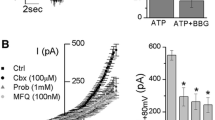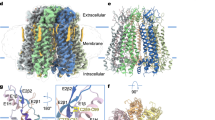Abstract
Activation of P2X7 receptor (P2X7R) and pannexin have been implicated in membrane permeabilization associated with ischemic cell death and many other inflammatory processes. P2X7R has a unique property of forming large pore upon repeated or prolonged application of agonist like ATP or 2′, 3′-(4-benzoyl) benzoyl ATP. It has been proposed that pannexin 1 (panx1) hemichannel associates with P2X7R to form large pore, though the actual mechanism is not yet understood. Calcium concentration in extracellular milieu drops in many patho-physiological conditions, e.g. ischemia, when P2X7R/pannexin is also known to be activated. Therefore, we hypothesize that extracellular calcium ([Ca2+]o) plays an important role in the coupling of P2X7R–panx1 and subsequent membrane permeabilization. In this study we show that membrane permeability of the P2X7R and panx1 expressing N2A cell increases in ([Ca2+]o)-free solution. In [Ca2+]o-free solution, fluorescent dye calcein trapped cells exhibited time-dependent dye leakage resulting in about 50% decrease of fluorescence intensity in 30 min. Control cells in 2 mM [Ca2+]o did not show such leakage. Like N2A cells, mixed culture of neuron and glia, derived from hippocampal progenitor cells showed similar dye leakage. Dye leakage was blocked either by pannexin-specific blocker, carbenoxolone or P2X7R antagonists, Brilliant Blue G, and oxidized ATP. Furthermore P2X7R and panx1 were co-immunoprecipitated. The amount of P2X7R protein pulled-down with panx1, increased by twofold when cells were incubated 30 min in [Ca2+]o-free buffer. Taken together, the results of this study demonstrate the activation and association of P2X7R–panx1, triggered by the removal of [Ca2+]o.








Similar content being viewed by others
References
Adams DJ, Barakeh J, Laskey R, Van Breemen C (1989) Ion channels and regulation of intracellular calcium in vascular endothelial cells. FASEB J 3:2389–2400
Bao L, Locovei S, Dahl G (2004) Pannexin membrane channels are mechanosensitive conduits for ATP. FEBS Lett 572:65–68
Brown EM (1999) Physiology and pathophysiology of the extracellular calcium-sensing receptor. Am J Med 106:238–253
Bruzzone R, Barbe MT, Jakob NJ, Monyer H (2005) Pharmacological properties of homomeric and heteromeric pannexin hemichannels expressed in Xenopus oocytes. J Neurochem 92:1033–1043
Carafoli E (1987) Intracellular calcium homeostasis. Annu Rev Biochem 56:395–433
Chekeni FB, Elliott MR, Sandilos JK, Walk SF, Kinchen JM, Lazarowski ER, Armstrong AJ, Penuela S, Laird DW, Salvesen GS, Isakson BE, Bayliss DA, Ravichandran KS (2010) Pannexin 1 channels mediate ‘find-me’ signal release and membrane permeability during apoptosis. Nature 467:863–867
Cheng HP, Wei S, Wei LP, Verkhratsky A (2006) Calcium signaling in physiology and pathophysiology. Acta Pharmacol Sin 27:767–772
Contreras JE, Sanchez HA, Eugenin EA, Speidel D, Theis M, Willecke K, Bukauskas FF, Bennett MV, Saez JC (2002) Metabolic inhibition induces opening of unapposed connexin 43 gap junction hemichannels and reduces gap junctional communication in cortical astrocytes in culture. Proc Natl Acad Sci USA 99:495–500
D'Hondt C, Ponsaerts R, De Smedt H, Bultynck G, Himpens B (2009) Pannexins, distant relatives of the connexin family with specific cellular functions? Bioessays 31:953–974
Domercq M, Perez-Samartin A, Aparicio D, Alberdi E, Pampliega O, Matute C (2010) P2X7 receptors mediate ischemic damage to oligodendrocytes. Glia 58:730–740
Ferrari D, Pizzirani C, Adinolfi E, Lemoli RM, Curti A, Idzko M, Panther E, Di Virgilio F (2006) The P2X7 receptor: a key player in IL-1 processing and release. J Immunol 176:3877–3883
Gendron FP, Chalimoniuk M, Strosznajder J, Shen S, Gonzalez FA, Weisman GA, Sun GY (2003) P2X7 nucleotide receptor activation enhances IFN gamma-induced type II nitric oxide synthase activity in BV-2 microglial cells. J Neurochem 87:344–352
Huang YJ, Maruyama Y, Dvoryanchikov G, Pereira E, Chaudhari N, Roper SD (2007) The role of pannexin 1 hemichannels in ATP release and cell-cell communication in mouse taste buds. Proc Natl Acad Sci USA 104:6436–6441
Humphreys BD, Rice J, Kertesy SB, Dubyak GR (2000) Stress-activated protein kinase/JNK activation and apoptotic induction by the macrophage P2X7 nucleotide receptor. J Biol Chem 275:26792–26798
Iglesias R, Dahl G, Qiu F, Spray DC, Scemes E (2009) Pannexin 1: the molecular substrate of astrocyte "hemichannels". J Neurosci 29:7092–7097
Jhaveri DJ, Mackay EW, Hamlin AS, Marathe SV, Nandam LS, Vaidya VA, Bartlett PF (2010) Norepinephrine directly activates adult hippocampal precursors via beta3-adrenergic receptors. J Neurosci 30(7):2795–2806
Jiang LH (2009) Inhibition of P2X7 receptors by divalent cations: old action and new insight. Eur Biophys J 38:339–346
Johnson JP Jr, Balser JR, Bennett PB (2001) A novel extracellular calcium sensing mechanism in voltage-gated potassium ion channels. J Neurosci 21:4143–4153
Kawabata S, Tsutsumi R, Kohara A, Yamaguchi T, Nakanishi S, Okada M (1996) Control of calcium oscillations by phosphorylation of metabotropic glutamate receptors. Nature 383:89–92
Kristian T, Siesjo BK (1998) Calcium in ischemic cell death. Stroke 29:705–718
Liang L, Schwiebert EM (2005) Large pore formation uniquely associated with P2X7 purinergic receptor channels. Focus on "Are second messengers crucial for opening the pore associated with P2X7 receptor?". Am J Physiol Cell Physiol 288:C240–242
Lipton P (1999) Ischemic cell death in brain neurons. Physiol Rev 79:1431–1568
Locovei S, Scemes E, Qiu F, Spray DC, Dahl G (2007) Pannexin1 is part of the pore forming unit of the P2X7 receptor death complex. FEBS Lett 581:483–488
Madesh M, Hajnoczky G (2001) VDAC-dependent permeabilization of the outer mitochondrial membrane by superoxide induces rapid and massive cytochrome c release. J Cell Biol 155:1003–1015
Mao AJ, Bechberger J, Lidington D, Galipeau J, Laird DW, Naus CC (2000) Neuronal differentiation and growth control of neuro-2a cells after retroviral gene delivery of connexin43. J Biol Chem 275:34407–34414
Mariathasan S, Weiss DS, Newton K, McBride J, O'Rourke K, Roose-Girma M, Lee WP, Weinrauch Y, Monack DM, Dixit VM (2006) Cryopyrin activates the inflammasome in response to toxins and ATP. Nature 440:228–232
Massimini M, Amzica F (2001) Extracellular calcium fluctuations and intracellular potentials in the cortex during the slow sleep oscillation. J Neurophysiol 85:1346–1350
Murgia M, Hanau S, Pizzo P, Rippa M, Di Virgilio F (1993) Oxidized ATP—an irreversible inhibitor of the macrophage purinergic P2Z receptor. J Biol Chem 266(11):8199–8203
Nicholson C, ten Bruggencate G, Stockle H, Steinberg R (1978) Calcium and potassium changes in extracellular microenvironment of cat cerebellar cortex. J Neurophysiol 41:1026–1039
North RA (2002) Molecular physiology of P2X receptors. Physiol Rev 82:1013–1067
Pelegrin P, Surprenant A (2006) Pannexin-1 mediates large pore formation and interleukin-1beta release by the ATP-gated P2X7 receptor. EMBO J 25:5071–5082
Rassendren F, Buell GN, Virginio C, Collo G, North RA, Surprenant A (1997) The permeabilizing ATP receptor, P2X7. Cloning and expression of a human cDNA. J Biol Chem 272:5482–5486
Silverman WR, de Rivero Vaccari JP, Locovei S, Qiu F, Carlsson SK, Scemes E, Keane RW, Dahl G (2009) The pannexin 1 channel activates the inflammasome in neurons and astrocytes. J Biol Chem 284:18143–18151
Suadicani SO, Brosnan CF, Scemes E (2006) P2X7 receptors mediate ATP release and amplification of astrocytic intercellular Ca2+ signaling. J Neurosci 26:1378–1385
Tatham PE, Cusack NJ, Gomperts BD (1988) Characterization of the ATP4- receptor that mediates permeabilization of rat mast cells. Eur J Pharmac 147:13–21
Vessey DA, Li L, Kelley M (2010) Pannexin-I/P2X7 purinergic receptor channels mediate the release of cardioprotectants induced by ischemic pre- and postconditioning. J Cardiovasc Pharmacol Ther 15:190–195
Virginio C, MacKenzie A, North RA, Surprenant A (1999) Kinetics of cell lysis, dye uptake and permeability changes in cells expressing the rat P2X7 receptor. J Physiol 519(Pt 2):335–346
Woehrle T, Yip L, Elkhal A, Sumi Y, Chen Y, Yao Y, Insel PA, Junger WG (2010) Pannexin-1 hemichannel-mediated ATP release together with P2X1 and P2X4 receptors regulate T-cell activation at the immune synapse. Blood 116:3475–3484
Yao H, Haddad GG (2004) Calcium and pH homeostatsis in neurons during hypoxia and ischemia. Cell Calcium 36:247–255
Zhang Y, McBride DW, Hamill OP Jr (1998) The ion selectivity of a membrane conductance inactivated by extracellular calcium in Xenopus oocytes. J Physiol 508(Pt 3):763–776
Zhang Z, Chen G, Zhou W, Song A, Xu T, Luo Q, Wang W, Gu XS, Duan S (2007) Regulated ATP release from astrocytes through lysosome exocytosis. Nat Cell Biol 9:945–953
Zhang L, Deng T, Sun Y, Liu K, Yang Y, Zheng X (2008) Role of nitric oxide in permeability of hippocampal neuronal hemichannels during oxygen glucose deprivation. J Neurosci Res 86:2281–2291
Acknowledgments
We would like to express our sincere gratitude to Dr. Roberto Bruzzone, Department of Neuroscience, Institut Pasteur, France for providing pannexin cDNA. We thank Professor David Spray, Albert Einstein College of Medicine, USA for providing P2X7R cDNA. We are grateful to Dr. Anjana Chandrasekhar, Parshuram Sonawane, Dr. Prasun Priya Nayak, and Dr. Sunitha Sukumaran for their helpful comments on the manuscript. This work was supported by the grants from BRNS, Department of Atomic Energy, Government of India.
Author information
Authors and Affiliations
Corresponding author
Additional information
V. Poornima and M. Madhupriya contributed equally to this work.
Rights and permissions
About this article
Cite this article
Poornima, V., Madhupriya, M., Kootar, S. et al. P2X7 Receptor–Pannexin 1 Hemichannel Association: Effect of Extracellular Calcium on Membrane Permeabilization. J Mol Neurosci 46, 585–594 (2012). https://doi.org/10.1007/s12031-011-9646-8
Received:
Accepted:
Published:
Issue Date:
DOI: https://doi.org/10.1007/s12031-011-9646-8




